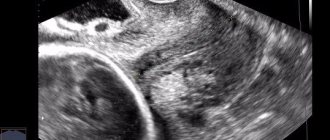Tank culture from the cervical canal is a simple and accessible method for determining microorganisms living in the cervical canal. It is prescribed only when the vaginal smear shows a poor result and there is an increased number of white blood cells.
It is especially important for pregnant women to take the test, because they are responsible for the health of the fetus developing in their body.
This analysis helps to recognize the causative agents of dangerous diseases, count their number and decide on an antibiotic that can be used to cope with the disease.
What is the cervical canal and what is its significance?
The canal is a through hole that connects the top of the vagina directly to the uterus. It is located inside the cervix.
- The length of this channel is about 4 cm.
- Width - about 8 mm, during childbirth - 10 cm.
- It has 2 narrowings: internal and external pharynx.
The external one is usually examined by a gynecologist using medical instruments. Nulliparous women have a pinpoint pharynx. And those who gave birth have a slit-like pharynx.
A smooth, pale pink canal is characteristic of young, healthy women. And during menopause, the mucous membrane is very pale, and almost no secretion is produced.
The main purpose of the canal is to protect against infectious diseases and facilitate the penetration of sperm into the uterus. Blood clots also pass through this channel during menstruation.
The female vagina contains a huge variety of microorganisms and fungi. And the uterus somehow remains sterile. A similar situation is possible thanks to the cervical canal. After all, in its walls there are many cells responsible for the production of special protective mucus.
At the very beginning and after the end of the menstrual cycle, mucus from the cervical canal has an acidic environment. The mucus from the cervical canal is very viscous and blocks the passage like a plug.
Harmful microorganisms die in this acidic environment. And spermatozoa in such an environment become incapable of fertilization. The level of estrogen can be determined by stretching the mucus; the longer the thread, the more hormones in the body.
Already in the middle of the monthly cycle, estrogen levels increase significantly, and the mucus becomes thin and alkaline. And sperm gain access to the eggs of the uterus.
But after conception, the ovaries produce progesterone, and the mucus in the cervical canal becomes more viscous. A thick mucus plug forms. It protects the fetus from pathogenic bacteria. Before birth, this plug comes out of the canal.
What is tank seeding?
Tank culture is a bacteriological analysis that is used to determine what kind of microorganisms inhabit the cervical canal.
What is it used for:
- If the study reveals pathogenic microflora, the doctor prescribes specific antibiotics to destroy the infection. After all, the results of the analysis provide a detailed picture of the organisms inhabiting the cervical canal and what medications need to be taken to combat the disease.
- In addition, this analysis helps determine the nature of the positive bacteria that are involved in metabolism. The study helps determine the presence and type of fungi living in the genitals.
- With its help, thrush is detected and methods of treatment for this disease are selected..
- The analysis helps to identify microorganisms that cause inflammatory processes (citrobacteria, enterococci, staphylococci).
Tests are carried out on the basis of a scraping from the cervical canal; it is absolutely painless. And biomaterial with microorganisms taken in this way can also be examined for reaction to antibiotics. Analysis is required for complications during pregnancy and inflammatory diseases of the cervix.
How is the analysis carried out?
Analysis steps:
- When taking scrapings, only a sterile brush is used. With its help, the secretion of the glands located there and desquamated cells containing microorganisms are taken from the cervical canal.
- The taken biomaterial is immediately placed in a glass tube with a nutrient medium.
- All kinds of bacteria and fungi placed in such favorable conditions begin to multiply. The main thing is not to let them die, because in this case it will be impossible to identify the causative agents of dangerous infections.
- For this purpose, a glass tube with biomaterial for research is placed in a thermostat in which a constant temperature of 37 degrees is maintained.
- When the test tube gets to the laboratory , its contents are applied to another nutrient medium, which is located in a Petri dish.
- The bowl with microorganisms is placed in a thermostat for a few more days so that the process of bacterial reproduction begins.
- A few days later , when there is sufficient material for research, the types of microorganisms are determined, the number of units within each type is counted, and tests for antibiotics are carried out.
Why is a tank culture test prescribed?
Culture tests are prescribed to take a biological sample from the walls of the cervix for further examination in the laboratory. A sample is taken if the doctor suspects an infectious disease of the genital organs.
That is why the gynecologist first prescribes a bacterial examination of the cervical canal, and then prescribes treatment.
When conducting a bacterial study, you can identify:
- various fungi;
- enterococci;
- Trichomonas;
- epithelial cells;
- leukocytes;
- staphylococci;
- gonococci.
This type of analysis is one of the most informative methods for identifying dangerous bacteria.
The data obtained through research is deciphered, and then treatment is prescribed. But it is possible to carry out bacterial analysis for preventive purposes.
Who should donate the seed tank to?
Analysis of biomaterial from the cervical canal should be taken:
- for infectious diseases of the female genital organs;
- annually as a preventive study;
- when there are coccal bacteria in a vaginal smear for microflora;
- leukocyte counts are increased in the smear;
- with frequent inflammation of the genital organs;
- for any uncharacteristic vaginal discharge;
- during and during expected pregnancy.
What is bacterial seeding?
In general, bacterial culture is intended to identify foci of infection, as well as the onset of inflammation . To carry it out, any of the human body fluids is required, such as blood, urine, mucous discharge from the nose, etc.
Using special conditions, in particular, creating a nutrient medium from material provided by the patient, they try to grow bacteria. Then they study the content and draw conclusions . Moreover, the study determines not only the presence of certain bacteria, but also their sensitivity to the most common antibiotics. Thus, based on the culture result, the doctor will be able to not only find out what pathogenic bacteria are present in the body, but also how they can be most effectively treated .
Preparing for analysis
Preparing for the study:
do not have sex the day before tests;
- do not take medications (especially antibiotics) two weeks before the test;
- do not use creams or gels for intimate procedures;
- prepare and refrain from any hygiene procedures before submitting samples;
- do not go to the toilet before submitting samples;
- do not douche or use candles;
- wait a few days if colposcopy was performed;
- Do not take tests during your period, but 7 days after the end.
Tank seeding during pregnancy
Pregnant women need to take a bacterial test from the cervical canal.
After all, it is in this canal that pathogenic bacteria accumulate, which can harm the fetus.
In order for the pregnancy to proceed without problems and the child to be healthy, it is necessary to detect the infection in time and cure the disease.
But bacterial analysis from the canal is not prescribed to all pregnant women. When registering, women must undergo a general smear test.
And if the content of leukocytes in it is increased, then the doctor prescribes an additional test for culture. A high percentage of leukocytes indicates an inflammatory process. And which bacteria caused the disease can only be determined by analysis from the cervical canal.
Smear culture during pregnancy: purpose of the study, norms and deviations
The female body during pregnancy is predisposed to various diseases, since the immune system is too weakened. The bright prospects of bearing and giving birth to a healthy baby can collapse due to the appearance of infection, bacteria of various origins. In this regard, doctors prescribe a huge number of tests, one of which is culture.
What is tank smear culture
Bacteriological culture is an analysis to determine the provoking factor and how sensitive it is to a particular drug.
This research method is widely used in medicine.
Almost any liquid biological material can become a substance for study. Collection from the genitals is preferable.
Based on the results, correct and successful treatment can be prescribed.
Objectives of the study
In the female reproductive system, the balance of the acidic environment plays an important role. It consists of protective microbes that prevent infections from entering.
Under the influence of negative factors, pathogenic bacteria multiply to huge numbers and exceed the indicators. A chain reaction of inflammation occurs.
A smear culture during pregnancy is prescribed to identify harmful bacteria. The doctor takes a smear from the genital mucosa, since then the most accurate results are obtained.
Bacteria are placed in a comfortable environment for them to develop and examined under a microscope.
Bacteriological culture plays a huge role in the detection of infectious diseases. Research methods may differ, but the goal is the same: to obtain indications and identify pathogens without foreign impurities.
Indications for analysis
What is the sowing tank used for? Biological material from pregnant women can be examined routinely at scheduled times at the discretion of the gynecologist. The fence is made from the cervical canal.
Also prescribed according to some indicators:
- when a woman plans to become a mother in the near future;
- with inflammation of the female genital organs and
- microflora disorders;
- if the results of the previous smear are questionable;
- in cases where the uterus is constantly susceptible to infection.
The various visible manifestations of infectious diseases are also taken into account. For example, unpleasant vaginal discharge, itching, burning, irritation.
Using this diagnostic method, you can determine why the menstrual cycle is delayed.
For pregnant women, the test is prescribed if a genitourinary infection is suspected, or for the purpose of its prevention.
The development of pathogenic infectious parasites in the uterus cannot be ignored. This can lead to miscarriage or infection of the fetus.
How the research is carried out
Tank seeding from the cervical canal during pregnancy is carried out quite often. With normal gestation, this occurs at 30 weeks.
If there are specific complaints or there have been previous miscarriages, infection of the fetus in the womb, and so on, a smear is given as prescribed by a doctor.
The collection of material is carried out by a midwife or nurse from the antenatal clinic.
In this case, preparation for tank sowing includes:
- exclusion of water hygiene procedures;
- you cannot douche and use antiseptics;
- do not insert suppositories or other medications;
- if during planning the procedure coincides with menstruation, then a smear cannot be taken; it is taken 2 days after the complete end of menstruation;
- tank analysis is not taken immediately after colposcopy;
- Any treatment that includes antibiotics or drugs interferes with reliable results.
The patient is positioned on a gynecological chair. The health care provider inserts a speculum into the vagina and then uses a sterile probe with a small loop to take a swab.
The procedure is absolutely painless and safe for the child.
What does the results show?
The female genital organs have many microorganisms in their flora. Some of them do not pose a danger, and some are not the norm for beneficial gestation.
Normal tests should show the presence of: lactobacilli, bifidobacteria. Other microorganisms that are inherent in the intestines should not be detected, except in a single quantity.
If the culture shows a large accumulation of them, this indicates that the genitourinary system is inflamed.
Norms
The following indicators are considered normal results:
- in the cervical canal no more than 30 units of leukocytes;
- in the vagina 3 times less;
- up to 5 units should be in the urethra;
- squamous epithelium can range from 5 to 10 units.
Harmful bacteria that depress the body must be completely absent.
What do deviations mean?
The results do not always show normal values. Poor culture during pregnancy is not uncommon.
Depending on the identified pathology, possible treatment options are considered.
The absence of squamous epithelium indicates a decrease in estrogen; an excess of these components indicates inflammation.
Yeast-like fungi indicate characteristic diseases, for example staphylococcus in the cervical canal in pregnant women.
Abundant mucous discharge also indicates inflammatory processes.
In connection with the detection of any deviations from the norms, additional procedures are prescribed. A pregnant woman undergoes tests to examine vaginal discharge.
First of all, they consider options for harmful bacteria acquired through sexual contact.
Treatment is prescribed based on the timing of pregnancy.
The preferred treatment option during this period is topical remedies without antibiotics. Medicines should not adversely affect the fetus.
In the second trimester, more radical methods are allowed, but in case of urgent need.
Important! There are infections that do not manifest their existence openly in the body. That is, they develop in a latent form and affect the development of the child while in the womb. Therefore, even without any apparent reason, it is advisable to take this test.
Degrees of quality and growth of bacteria
There are microorganisms that live without actively manifesting themselves. At the time of immune and hormonal disorders, they are activated and begin to actively multiply. Each of the parasites finds its own habitat, where it is more comfortable. That is why one or another flora is used for analysis.
The results of the readings are based on the possibility of rapid development of harmful microorganisms.
The following options are possible:
- first degree. This is when there is a slight growth of bacteria and only relative to its environment;
- the next step is about a dozen colonies in another solid medium;
- at the third stage there is an increase to 100 colonies;
- in the last stage, more than 100 colonies of the same type are observed.
The primary two degrees of proliferation of microorganisms indicate clogging in the microflora, and the latter show inflammation.
These changes do not exclude the possibility of development associated with the interesting position of a woman during which hormonal changes occur, immunity decreases, and medications are used.
The entry of an infection into the body and its rapid reproduction can bring not only physical discomfort to the expectant mother in the form of itching, burning and discharge. For this reason, miscarriages, infections of the child during passage through the birth canal, and many other troubles occur.
To ensure a successful pregnancy, take care of your health in advance.
Daria Andreevna, neonatologist
Especially for the site kakrodit.ru
Indicators are normal
The canal is populated by various microorganisms; it cannot be completely sterile. Lysozyme contained in the secretion of the canal has an antimicrobial effect.
Beneficial bacteria must be present in the cervix. But just one harmful bacteria, for example, staphylococcus, indicates an infection and the need for treatment.
The composition of the microflora depends on:
- on the age of the woman;
- presence of infection;
- hormonal levels;
- taking antibiotics;
- various pathologies.
The analysis provides data on the microorganisms inhabiting the cervix. A normal indicator should not contain any fungi or bacteria.
However, there must be beneficial bifidobacteria and lactobacilli, but not less than 10.7. Indicators of E. coli – 10.2 enterococci. Leukocytes are normal up to 30. Flat epithelium – 5-10. There should be a moderate amount of mucus.
Pathological is a condition in which a large number of E. coli, gonococci, yeast fungi, staphylococci, and trichomonas are found. This analysis is not able to detect chlamydia and ureaplasma.
Decoding the results
The gynecologist interprets the results obtained from the laboratory. The analysis shows the name of the microorganisms inhabiting the cervix, as well as one of the 4 levels of cleanliness of the canal.
There are 4 levels of channel purity:
- Microorganisms show little growth. They are present in liquid media, but not in solid media.
- Bacteria of one type show growth of up to 10 colonies on a hard surface.
- The number of bacteria is up to 100 colonies on a solid medium.
- The number of different colonies is more than 100.
The first two degrees indicate contamination of the canal, and the third and fourth degrees indicate inflammatory processes.
And the reasons for the increased number of bacteria in the cervix are decreased immunity, hormonal imbalances, taking antibiotics, hereditary diseases, poor hygiene, infection during sexual intercourse, infection due to medical procedures.
Tank culture for the presence of bacteria can also determine sensitivity to various antibiotics. Bacteria whose sensitivity needs to be determined are placed in a dish with a nutrient medium. Discs soaked in antibiotics are placed on the surface of the medium.
This antibiotic penetrates the environment and affects the growth of microorganisms. The bowl should stand for some time at room temperature, and then it is placed in a thermostat for several hours.
After the required amount of time has passed, the diameter of the growth inhibition zone is measured and the suppression of bacterial growth is assessed:
- the absence of growth inhibition indicates bacterial resistance to the drug;
- zone diameter up to 1.5 cm – weak reaction, low effectiveness of the product;
- zone diameter from 1.5 to 2.5 cm – moderate sensitivity;
- diameter greater than 2.5 cm – hypersensitivity to antibiotics.
It is important to determine sensitivity to antibiotics, because in different women, bacteria react differently to certain medications. You cannot prescribe medications based only on textbook recommendations. It is necessary to find out which antibiotic can cope with the disease.
How is cervical canal culture performed?
The cervical canal connects the uterus to the vagina. In shape, this part of the female reproductive system resembles a spindle: on the outside it is connected to the vagina, and on the inside to the uterine cavity using an internal opening.
How the organ works
The mucous membrane covers the cervical canal from the inside. In shape, it resembles a cylinder, which consists of epithelium and produces female secretions.
The channel serves as a conducting tunnel. Discharge during menstruation passes through it, and sperm penetrate into the uterus.
The width of the canal is individual for each woman, but on average it is 7 mm. The shape changes over the years. Changes occur due to:
- childbirth;
- abortions;
- age;
- changes in hormonal levels and microflora.
Every year, every woman is required to take a culture from the cervical canal.
Culture and smear of material
When bacteria or pathogenic microorganisms enter the vagina, endocervicitis, an inflammatory process, develops. The normal state of microflora guarantees compliance with hygiene rules. Causes of endocervicitis:
- violation of hygiene rules;
- decreased metabolic rate;
- inflammation of the genitourinary system;
- hormonal instability;
- incorrect antibacterial therapy.
The disease occurs in chronic and acute forms. Women's immunity and the structure of bacteria influence the degree of development of the inflammatory process.
The disease may not appear for a long time.
To determine the infection, a smear and culture of the flora from the cervical canal of the vagina are analyzed. The gynecologist prescribes microscopy of the obtained material. A smear is taken using a special brush and then analyzed.
A day before the smear, the woman does not douche and excludes sexual intercourse so that the result is reliable. A smear from the cervical canal will show normal if the analysis results correspond to the following numbers:
- lactobacilli – 10×7;
- yeast fungi – 10x2;
- E. coli – 10x2;
- enterococci – no more than 10x2 CFU/ml.
Bacteriological culture
More often, a smear is taken from the cervical canal from pregnant women to check the condition of the reproductive organ.
The culture tank is assigned second, if necessary, after the first general analysis. If a high level of white blood cells is first detected, then the patient will be given a bacteriological culture. The procedure involves studying the flora and its sensitivity to antibiotics.
How is it carried out?
The woman lies down on a special chair. Afterwards, the doctor inserts the brush into the vagina and makes a scraping. The material from the cervical canal is placed in a test tube filled with a liquid substance and carefully closed.
Pregnant women are examined in exceptional cases. Often, the expectant mother is worried that this will harm the embryo. But a miscarriage will not happen if the doctor takes a smear.
The cervical canal in pregnant and non-pregnant women is quite long. Therefore, the instrument will not reach the fetus. The study is not mandatory. An analysis is carried out if there is evidence.
The collected material consists of cells and mucus that make up the microflora of the female organ. The material is placed in a test tube with a nutrient medium.
Nutrients help microorganisms develop. They determine the state of the internal microflora.
Watch a video about performing a culture from the cervical canal:
results
A positive result is given if the examination shows the presence of microorganisms. In this case, the exact level of development and growth position are established.
If, as a result of the study, there is no growth of microorganisms in the nutrient liquid medium, the woman’s vaginal microflora is contaminated.
If there is growth of a certain type of bacteria, inflammation has developed due to this pathogen. High growth of bacteria is observed with weakened immunity, metabolic disorders, instability or disruption of hormonal levels, and inflammation of the genitourinary organs.
Functioning of the cervical canal in pregnant women
During conception, the cervical canal changes color: before pregnancy, the hue of the space between the pharynx is bright pink, and after it is blue. With the appearance of blueness, the gynecologist determines the onset of pregnancy.
Mucus changes during pregnancy: it forms a dense plug. It protects the fetus by preventing pathogenic bacteria from entering the uterus. The time for the plug to peel off occurs individually: for some, 1.5 weeks before birth, for others, 2 hours.
Cervical fluid consists of elements:
- mucin;
- lysozyme;
- proteins;
- polysaccharides;
- electrolytes;
Moreover, 50% of its composition is water.
Estrogen and progesterone form cervical mucus. The first hormone causes the secretion to be produced abundantly during menstruation. Progesterone reduces this function to a minimum, making the mucus more dense.
During childbirth, the cervical canal begins to open up to 10 cm. This helps the woman easily endure the birth of the baby.
In some cases, the expectant mother is diagnosed with isthmic-cervical insufficiency. This means weak cervical support for the rapidly growing fetus. The development of pathology in pregnant women is recorded by the 18th week. The embryo grows and moves.
Sometimes, according to indications, surgery is prescribed to tighten the cervical canal. The seal is removed when it is time to give birth.
A woman should have a smear and culture done by a doctor. Both procedures are straightforward and completely painless. Timely testing eliminates the risk of developing infertility.
Source: https://helpmommy.ru/posev-cervikal-kanal/











